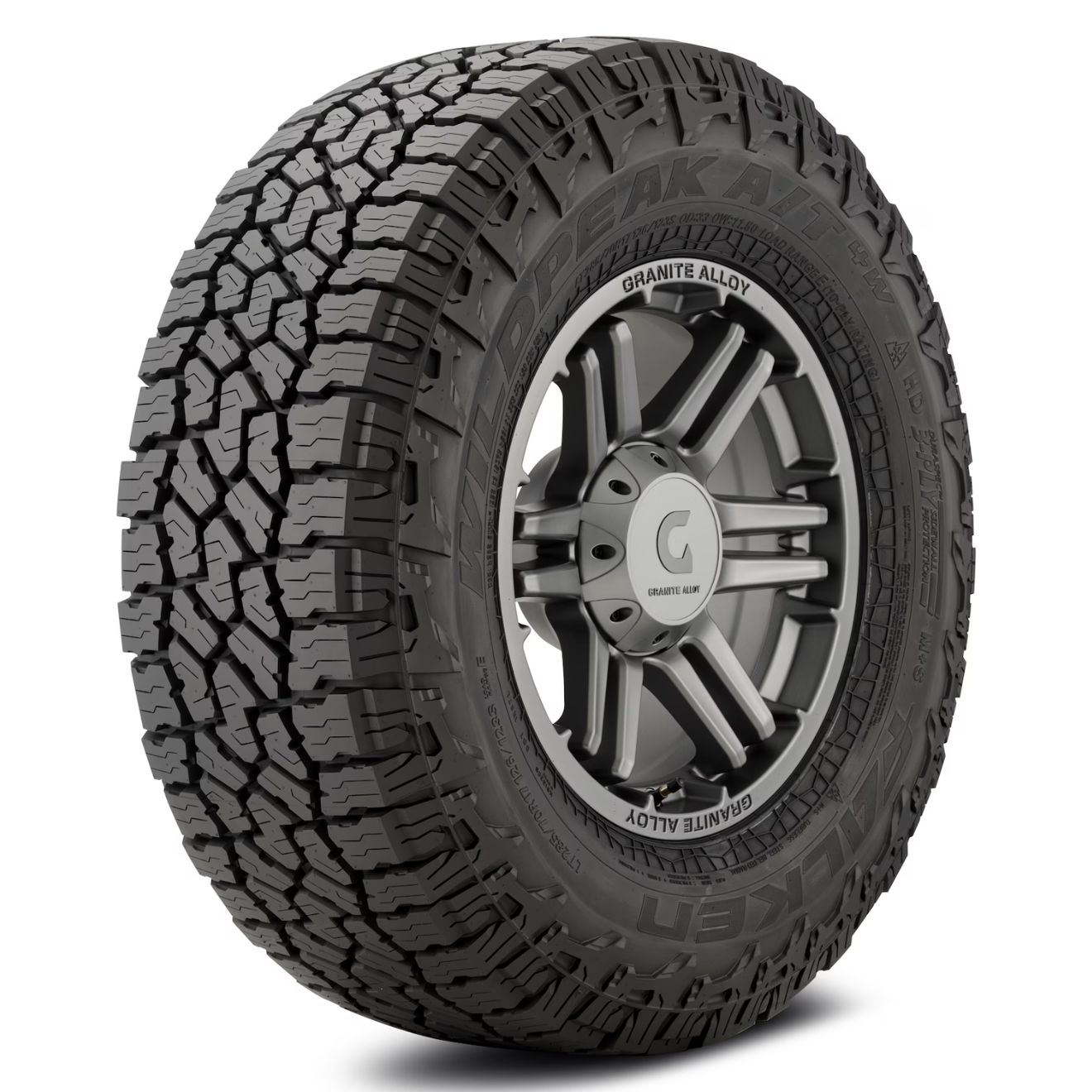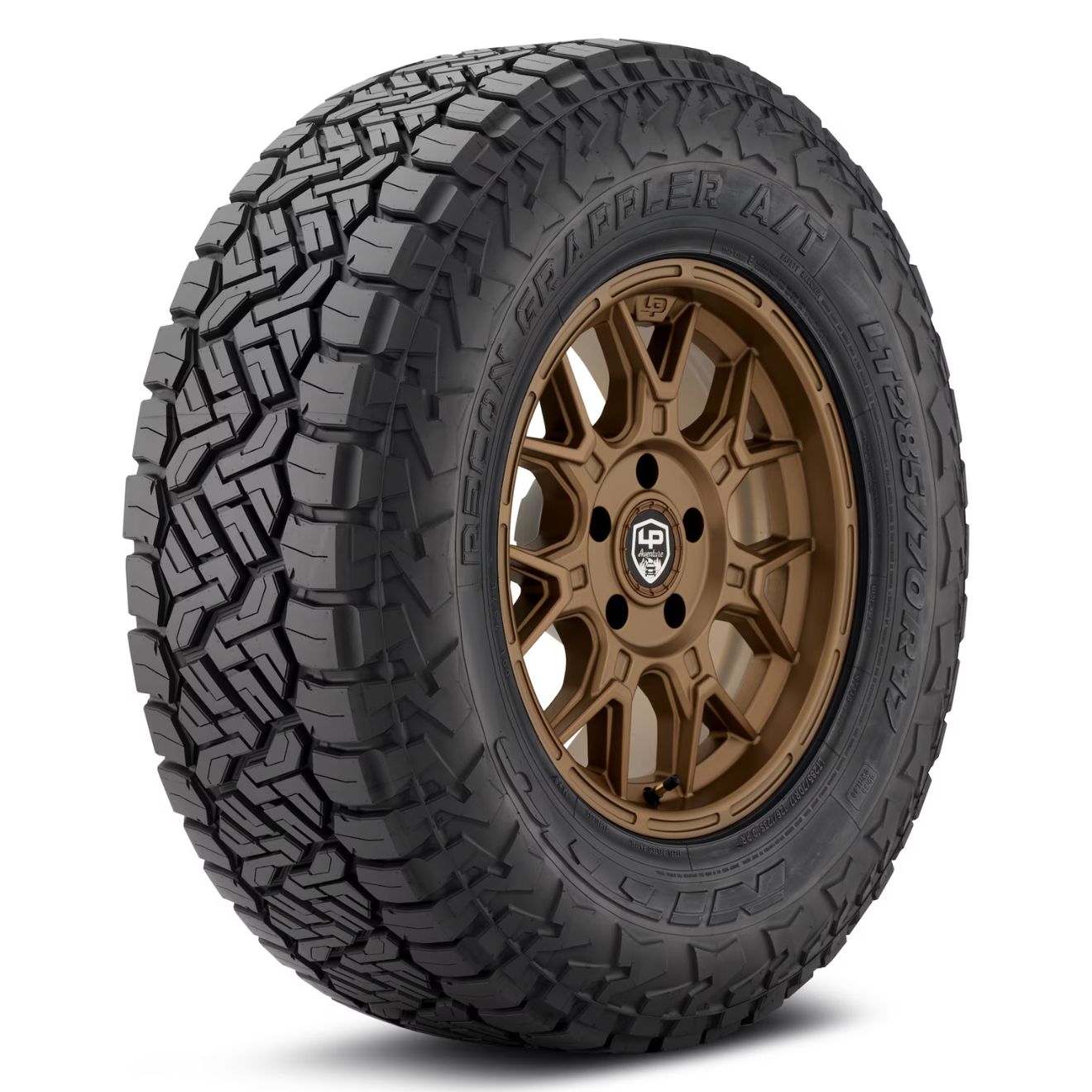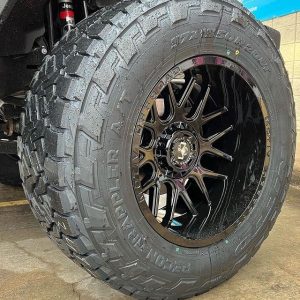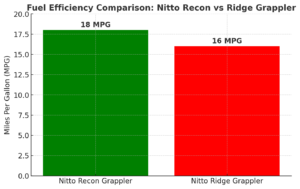Real-world test data, driver impressions, and community feedback — explained by a former Bridgestone test engineer.
The Nitto Recon Grappler A/T is a tougher, hybrid-leaning Off-Road A/T tire, built with a stiffer casing and blockier tread that shine under load and on gravel. The Falken Wildpeak AT4W, by contrast, is more road-friendly — tuned with a silica-rich compound and tighter tread pattern that feel safer in rain and steadier in winter. Snow-certified with the 3PMSF rating, the AT4W builds on the AT3W’s proven winter and all-weather reliability. For the full generational breakdown, see my Falken Wildpeak AT4W vs AT3W review.
That’s the real contrast — Recon for stiffness and gravel-ready durability vs AT4W for wet safety and winter stability. In the sections ahead, I’ll break down how they compare across dry, wet, snow, and off-road testing. You can also line them up in our All-Terrain Tire Decision Tool for quick recommendations tailored by SUV, CUV, or truck class.
Quick Look
The Nitto Recon Grappler A/T leans hard into toughness and hybrid A/T styling. With chunky shoulders, wide voids, and a stiff casing, it feels sharper off the line and steadier when towing heavy loads. At ~54 lbs in LT285 sizes, it’s lighter than Falken equivalents, which helps fuel economy and trailer stability. On-road, it reacts quickly to steering but demands caution in the wet, with longer stops (192 ft / 0.43 g) that require more margin. Off-road, it’s the bruiser — strong in dirt, mud, and rock, with a casing that resists cuts and chunking. Noise builds with miles, but its 55k–65k warranty is unusually strong for a hybrid A/T.
The Falken Wildpeak A/T4W is the more balanced daily partner. With tighter tread blocks, dense siping, and a silica-rich compound, it consistently brakes shorter in the wet (171 ft / 0.58 g) and grips better in snow and ice (69-ft snow, 45-ft ice). At 67 lbs in LT285, it’s heavier, but that weight brings deeper tread (up to 18/32″) and serious winter/off-road confidence. Comfort tips toward Falken too, with an 8.3/10 ride vs Recon’s 7.3, and its hum stays livable even as miles stack up. Backed by a 60k–65k warranty, it’s a tire built to last across climates.
👉 Bottom line: Recon = hybrid toughness with lighter weight & towing stability; AT4W = balanced grip, comfort, and true winter/off-road confidence.
Falken Wildpeak A/T4W

Nitto Recon Grappler A/T

Tire Decision Tool
For those in a hurry: this tool makes it easy. Just pick your vehicle and what matters most to you, and it’ll instantly suggest the best tire options.
Raw Test Data
Tire Test Data
Pick categories to show metrics, then open ☰ to pick tires. Optional chart is hidden by default.
Tread Pattern & Specs
Nitto Recon Grappler A/T
Look & build: Hybrid-style A/T with chunky shoulders, wide voids, and stone ejectors.
Weight: ~50 lb in LT265/70R17; ~54 lb in LT285/70R17. Lighter than Falken in equivalent LT sizes.
Warranty: 55k miles (LT); 65k miles (P-metric) — rare for a hybrid A/T.
UTQG: 600 A B (P-metric only).
Load options: Mostly LT E load, with some P-metric sizes like 285/70R17.
👉 Root cause: Lighter casing and 16/32″ tread depth (LT285) explain its efficiency and towing stability, but also why it trails Falken in wet grip.
Falken Wildpeak A/T4W
Look & build: Road-leaning A/T with tighter tread blocks, heavy siping, and silica compound.
Weight: ~46 lb in P265/70R17; ~53 lb in LT265/70R17; ~67 lb in LT285/70R17.
Warranty: 65k miles (P-metric); 60k miles (LT).
UTQG: 660 A B (P-metric only).
Load options: Broad spread: P-metric SL, LT C, and LT E with 3-ply DuraSpec sidewalls.
👉 Root cause: Deeper tread (up to 18/32″ in LT285) and heavier build = more winter/off-road grip and durability, but higher rolling resistance and stress on lighter trucks.
Dry Performance — Recon quicker to bite, Falken steadier once settled
On paper, Recon stops at 138 ft with 0.72 g cornering, while AT4W clocks 131.8 ft with 0.72 g. That means Falken technically brakes shorter, but the feel is different: Recon snaps quicker into a turn, while Falken takes a breath to settle, then holds the line with more authority.
Forum owners echo this. Recon drivers say it “feels sharper than expected for such an aggressive tread,” while Falken users highlight how it “tracks like stock once it settles in.” From my test seat, Recon’s aggressive block layout gives that eager initial feedback, but Falken’s reinforced shoulder and crown design reduce squirm, making it calmer when loaded.
SUVs & crossovers: Recon feels more lively; Falken steadier on longer curves.
½-tons: Recon fun unloaded; Falken safer with towing.
¾-tons & HD trucks: Falken clearly steadier — Recon flexes more under big mass.
👉 Verdict: Recon feels quicker on light rigs; Falken steadies once weight or load enters the picture.
Wet Performance — Falken safer margin, Recon stretches long
Here’s the biggest gap: Falken stops in 171 ft with 0.58 g traction, while Recon stretches out to 192 ft with 0.43 g. That’s one of the clearest trade-offs in this matchup.
Drivers back it up. Recon owners admit “you need more space in storms,” while Falken drivers say “confident even on slick highways.” The engineering explains it: Falken’s silica-rich compound and dense siping cut through surface water and resist hydroplaning, while Recon’s wider voids, tuned for off-road bite, displace rubber contact patch in heavy rain.
SUVs & crossovers: Falken the easy wet-weather choice.
½-tons: Falken inspires more confidence; Recon only manageable if driven with care.
¾-tons & HD trucks: Falken keeps trailers in line; Recon demands wide margins.
👉 Verdict: Falken wins wet safety hands-down; Recon demands patience and planning.
Note from the Expert: When it comes to rain, I always emphasize two things: compound grip and water evacuation. You can see the full details in my analysis, but if you take just one thing away, remember that an AT tire’s stiff nature makes achieving top-tier wet performance a constant battle. This is why the question, Are All-Terrain Tires Good in Rain?, requires a nuanced answer that balances tread design against rubber stiffness.
Winter & Snow — Recon claws loose powder, Falken steadier on pack
In snow testing, Recon posts a 74 ft stop and 45.5 ft launch, while Falken runs 69 ft and 41.5 ft. The split is clear: Recon claws harder in loose, fresh snow, but Falken digs in sooner on packed or plowed roads.
Community voices match: Recon drivers say it “powers through driveway drifts without issue,” while Falken owners note “predictable on salted and plowed lanes.” From my perspective, Recon’s aggressive shoulders and open voids give loose-snow bite, while Falken’s siping density and pliable compound keep braking shorter on polished surfaces.
SUVs & crossovers: Falken safer on daily plowed roads; Recon better in unplowed driveways.
½-tons: Falken the smarter commuter choice; Recon fun but less secure in pack.
¾-tons & HD trucks: Falken steadier under weight; Recon less confidence on polished winter roads.
👉 Verdict: Recon shines in loose snow; Falken steadier and safer when roads are maintained.
Note from the Expert: Our discussions often boil down to the core tradeoff. On one hand, you must understand why all-terrain tires are truly effective in deep snow, but not on ice. On the other hand, you face the 3PMSF Paradox—the hidden cost of that badge. The short answer is: The 3PMSF badge certifies traction, but it costs you durability. Dive into our full analysis on the critical 3PMSF rating for severe winter and off-road service, and its hidden costs, before you risk your rig on the trail.
Ice — Falken holds, Recon fades sooner
On ice, Falken stops in 45 ft, while Recon takes 46.5 ft. The numbers look close, but the feel isn’t. Recon tends to slide longer before catching, while Falken grips earlier and fades more predictably.
Owners describe it well: Recon is “fine if you creep and stay smooth,” while Falken “gives confidence even on frosty mornings.” The why comes down to micro-siping — Falken’s high siping density holds micro-edges in frozen temps, while Recon’s blockier tread loses those contact points faster.
SUVs & crossovers: Falken more forgiving.
½-tons: Falken keeps recovery time shorter; Recon needs caution.
¾-tons & HD trucks: Falken steadier under trailers; Recon can get skatey.
👉 Verdict: Falken is the safer ice option, even if neither is a dedicated winter tire.
Off-Road — Recon tougher, Falken balanced bite + comfort
Off-road scores tell the story. Recon logs 8.2 dirt / 8.0 sand / 8.3 mud / 8.1 rock, while Falken hits 8.5 / 8.2 / 8.5 / 8.8. Falken wins slightly in outright grip, especially on rocks and ruts, but Recon brings durability and toughness that shines on sharp gravel and mud.
Recon owners rave it’s “a beast in ruts and mud, takes abuse without chunking.” Falken users often say “planted and stable even on rough, rutted dirt roads.” Recon’s casing and void design keep it damage-resistant, while Falken’s deeper tread depth and aggressive siping make it stickier when climbing.
SUVs & crossovers: Falken more balanced; Recon overbuilt unless trails are routine.
½-tons: Recon excels in abuse; Falken more versatile overall.
¾-tons & HD trucks: Both solid — Recon wins durability, Falken wins traction.
👉 Verdict: Falken edges with grip versatility; Recon tougher and more resistant to abuse.
Note from the Expert: Every successful day on the trail is about preparation and physics, because tire longevity is earned, not given. Before you even start, you must master the critical link between tire pressure and load range for every rig to maximize your contact patch. Once moving, remember your ultimate off-road armor is your sidewall protection against the inevitable pinch flat. And finally, your traction on the obstacle is dictated by choosing the right aggressive vs hybrid tread pattern for your terrain. Master those three steps, and your rig will be ready for anything.
Comfort & Noise — Falken steadier, Recon grows louder
Recon comfort scores 7.3/10, while Falken comes in higher at 8.3/10. Recon rides firm and growls more as tread wears. Falken stays quieter longer, with a hum that blends into background.
Owners put it best: Recon is “quiet at first, but grows noisy around 20k miles.” Falken drivers say it’s “a little more noise than stock, but pleasant on the highway.” From an engineering standpoint, Recon’s larger voids naturally resonate more; Falken’s pitch sequencing calms that vibration.
SUVs & crossovers: Falken smoother and quieter.
½-tons: Recon livable, Falken nicer.
¾-tons & HD trucks: Falken blends into diesel or load; Recon feels rougher but not unbearable.
👉 Verdict: Falken is the refinement pick; Recon carries a firmer hum as it ages.
Note from the Expert: For years, choosing all-terrain meant accepting noise—a true compromise for off-road grip. That’s why the question, Are All-Terrain Tires Louder than Highway Tires?, used to have a simple “yes” answer. Now, with the rise of on-road models, the core issue has shifted from noise to overall refinement. To fully understand which side of the comfort spectrum you’re buying into, you need to determine Are All-Terrain Tires Good for Daily Driving?—a question that depends entirely on the tire’s construction, not just the name.
Treadwear & Longevity — Falken Lasts Longer
Falken carries a 65k warranty on P-metric sizes and 60k on LT sizes. Nitto offers 65k on P-metric sizes and 55k on LT.
In real life, Falken’s silica compound and tighter tread design tend to wear evenly, with many owners reporting balanced comfort even past 40k miles. Its LT versions with DuraSpec casing sacrifice a bit of tread life compared to P-metric, but the 60k rating is still strong for a tire with off-road chops.
Nitto’s Recon is tougher, resisting chips and cuts on gravel, but its blockier tread can wear unevenly on lighter vehicles. On heavy trucks or towing setups, the stiff casing distributes load more evenly, bringing it closer to its rated mileage. The P-metric Recon is the surprising twist here — at 65k miles, it matches Falken’s warranty while still carrying hybrid looks.
👉 Verdict: Falken is the safer bet for longer, balanced tread life across P and LT. Nitto trades mileage for extra toughness in LT, but its P-metric line offers a unique mix of hybrid styling with commuter-level longevity.
Geographic & Climatic Deep Dive
For drivers in the Snow Belt and wet regions—places like the Great Lakes, Northeast, Pacific Northwest, or the Rockies—the Falken Wildpeak A/T4W is the more dependable choice. Its Three-Peak Mountain Snowflake (3PMSF) rating isn’t just a badge, it’s a certification that matters when you’re commuting over snow-packed roads or climbing mountain passes that legally require winter-rated tires. The silica-rich compound keeps the tread flexible in freezing temperatures, and its shorter wet stopping distance (171 ft versus Nitto’s 192 ft) adds peace of mind in heavy rain or slush. If you’re running a Toyota 4Runner in Colorado, a Subaru Outback in Vermont, or an F-150 in Michigan, Falken offers the kind of predictable grip that makes winter driving safer.
By contrast, in arid and rugged regions like the Southwest deserts, West Texas highways, or the Great Plains, the Nitto Recon Grappler A/T comes into its own. The tougher, hybrid-style casing shrugs off cuts from sharp desert rock, and the lighter LT sizes (around 54 lbs compared to Falken’s 67 lbs in similar 285s) mean less rolling resistance on long, hot interstates. That helps preserve fuel economy while keeping the truck stable. If you’re in a Ram 1500 rolling across Arizona, a Jeep Gladiator tackling Utah slickrock, or a Toyota Tacoma racking up Texas miles, Recon feels purpose-built for your conditions.
When towing and hauling come into play, the difference is even clearer. The Recon Grappler stays planted under load thanks to its stiff carcass, limiting sway and squirm when a trailer is hooked up. The Wildpeak A/T4W rides softer and is more comfortable when empty, but with a heavy payload it can feel less locked in, particularly on winding highways.
👉 In short, Falken is the smarter fit for wet and snowy regions where safety comes first, while Nitto is the workhorse for hot, rugged landscapes and towing-heavy setups.
Tire Size Selection: The Basics You Can’t Skip
Even the best tread design can’t rescue a tire that’s built too weak. Back when I was testing tires at Bridgestone, I saw all-terrain models that should’ve performed but fell short — simply because the basics (size, load strength, and speed rating) weren’t matched to the vehicle.
P-Metric vs. LT (Light Truck) Tires
The first step is knowing whether you need LT or passenger tires. LT (Light Truck) tires are built with extra reinforcement and stiff sidewalls, designed for towing, hauling, or off-road use. Passenger (P-metric) tires are lighter, smoother, and tuned for daily comfort and fuel efficiency — but they’ll flex more under load.
Understanding Tire Load Range: XL vs. E-Load
Then comes the tire load index and load range — essentially your tire’s strength rating. Here’s where things split between passenger XL and LT E:
XL (Extra Load) is a passenger tire with reinforced sidewalls. It can handle a bit more pressure (~41 PSI) than a standard SL tire and is perfect for SUVs, crossovers, or light trucks that carry extra gear, passengers, or small trailers. XL tires ride softer and quieter than LT options, making them ideal for daily use.
E Load Range is an LT tire class built with a much thicker casing. E-rated tires can handle far more pressure (up to ~80 PSI) and heavier loads, which makes them essential for ¾-ton and 1-ton trucks towing trailers or hauling close to max capacity. The trade-off is weight, stiffer ride, more road noise, and a small drop in fuel efficiency.
Put simply: XL is for “extra luggage and family,” while E is for “truck bed full of bricks or a car trailer.”
Why the Tire Speed Rating Matters for Safety
Finally, don’t overlook the tire speed rating. It’s not just about top speed — it measures how well a tire handles heat and stress at highway pace. Lower ratings (like S) tend to ride softer and last longer, while higher ratings (H, T) feel more stable and responsive under sharp maneuvers. Heat build-up is the silent killer of tires, and speed rating is your safeguard.
Bottom line: Match your tire’s construction (LT vs P-metric), load range (XL vs E), and speed rating to your vehicle’s demands. Get those right, and everything else — off-road grip, winter traction, comfort — will finally perform the way it was designed to.
Final Verdict
| Performance Metric | Nitto Recon Grappler A/T | Falken Wildpeak A/T4W |
|---|---|---|
| Dry Stopping (60–0 mph) | 140 ft | 132 ft 🏆 Winner |
| Dry Cornering (g) | 0.70 g | 0.72 g 🏆 Winner |
| Wet Stopping (60–0 mph) | 192 ft | 171 ft 🏆 Winner |
| Wet Grip (g) | 0.43 g | 0.58 g 🏆 Winner |
| Winter Stopping (25–0 mph) | 74 ft | 69 ft 🏆 Winner |
| Snow Accel (0–12 mph) | 45.5 ft | 41.5 ft 🏆 Winner |
| Ice Stopping (ft) | 46.5 ft | 45 ft 🏆 Winner |
| Noise & Comfort | 6.80 | 6.92 🏆 Winner |
| Treadwear Warranty | 55k | 65k 🏆 Winner |
For drivers in wet or snowy climates, the Falken Wildpeak A/T4W is the safer bet. It delivers shorter wet and ice stops, calmer winter handling, and quieter road manners, making it ideal for Great Lakes, Northeast, Rockies, and Pacific Northwest regions. SUVs, crossovers, and ½-ton trucks see the biggest benefits.
The Nitto Recon Grappler A/T is better suited for drier, rugged landscapes. Its lighter LT casing and cut-resistant design make it perfect for Southwest deserts, West Texas, and long-haul towing. It’s the pick for half-ton and ¾-ton trucks that need towing stability and off-road durability more than polished wet-road manners.
👉 Bottom line: Falken = safer in storms and snow, longer life, and better comfort. Nitto = tougher casing, towing confidence, and hybrid looks for dry, rugged duty.
📌 Note on Upsizing to 285/70R17
Nitto 285 LT (~54 lb, 16/32″ tread depth): lighter, easier on mpg/braking, better for stance-focused daily use. Also offered in P-metric (65k warranty) — rare for a tire this aggressive.
Falken 285 LT (~67 lb, 18/32″ tread depth): heavier, with more rubber + 3-ply DuraSpec sidewall for true off-roaders, but adds drag and stress on lighter trucks.
Bottom line: If your truck is a workhorse, go Recon. If it’s a daily/family hauler, go Falken. If you’re upsizing to 285s, Recon keeps road manners intact, while Falken doubles down on LT strength.
Frequently Asked Questions: Nitto Recon Grappler A/T vs Falken Wildpeak A/T4W
Which tire is better on dry pavement?
Recon feels sharper on turn-in, while Falken steadies out once loaded. Falken also posts a shorter 131.8-ft stop versus Recon’s 138 ft.Which tire is safer in wet conditions?
Falken clearly wins, stopping in 171 ft with 0.58 g traction, compared to Recon’s longer 192 ft / 0.43 g result.Which tire performs better in snow?
Recon claws better in loose drifts, but Falken brakes shorter and steadier on packed or plowed winter roads.Which tire is more secure on ice?
Falken stops shorter at 45 ft and grips earlier, while Recon tends to slide longer before catching at 46.5 ft.Which tire is stronger off-road?
Recon resists cuts and abuse better, but Falken posts slightly higher dirt, sand, and rock grip scores thanks to deeper tread and siping.Which tire is quieter on the highway?
Falken wins with an 8.3/10 comfort rating, while Recon grows louder as tread wears, scoring 7.3/10.Which tire lasts longer?
Falken offers 65k (P-metric) / 60k (LT) warranties and tends to wear evenly. Recon carries 65k (P) / 55k (LT), but its blockier tread can wear unevenly.Who should choose the Nitto Recon Grappler A/T?
Drivers in dry, rugged regions (Southwest, Texas, desert) or those towing/hauling heavy loads who need durability and hybrid looks.Who should choose the Falken Wildpeak A/T4W?
Drivers in wet or snowy regions who want predictable all-weather grip, quieter comfort, and longer tread life, especially for SUVs and ½-ton trucks.












